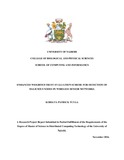Enhanced weighted trust evaluation scheme for detection of malicious nodes in wireless sensor networks.

View/
Date
2016-11Author
Koriata, Patrick T
Type
ThesisLanguage
enMetadata
Show full item recordAbstract
Wireless Sensor Networks (WSNs) present myriad application opportunities for several applications such as precision agriculture, environmental and habitat monitoring, traffic control, industrial process monitoring and control, home automation and mission-critical surveillance applications such as military surveillance, healthcare (elderly, home monitoring) applications, disaster relief and management, fire detection applications among others. Since WSNs are used in mission-critical tasks, security is an essential requirement. Sensor nodes can easily be compromised by an adversary due to unique constraints inherent in WSNs such as limited sensor node energy, limited computation and communication capabilities and the hostile deployment environments. These unique challenges render existing traditional security schemes used in traditional networks inadequate and inefficient. An adversary may take control of some sensor nodes and use them to inject false data with the aim of misleading the network’s operator (Byzantine attack). It is therefore critical to detect and isolate malicious nodes so as to prevent attacks that can be launched from these nodes and more importantly avoid being misled by falsified information introduced by the adversary via them. This research gives emphasis on improving Weighted Trust Evaluation (WTE) as a technique for detecting and isolating the malicious nodes. Extensive simulation is performed using MATLAB in which the results show the proposed WTE based algorithm has the ability to detect and isolate malicious nodes, both the malicious sensor nodes and the malicious cluster heads (forwarding nodes) in WSNs at a reasonable detection rate and short response time whilst achieving good scalability.
Publisher
University of Nairobi
